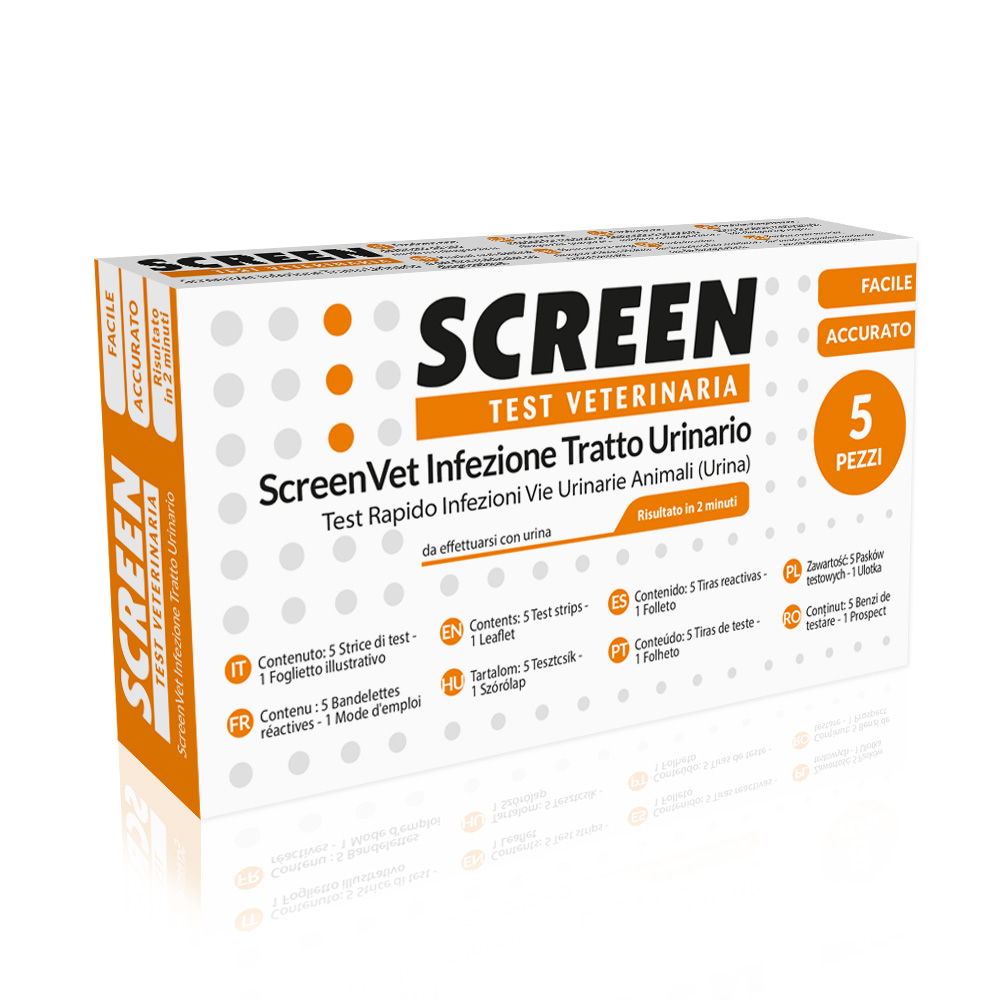
ScreenVet Urinary Tract Infection 5 Pcs.
PHARMACIST CODE: 984705816 – RETAIL PRICE €. 12,00
The test strips are designed for the qualitative and semi-quantitative detection of one or more of the following analytes in urine: Ascorbic acid, Glucose, Bilirubin, Ketone (acetoacetic acid), Specific gravity, Blood, pH, Protein, Urobilinogen, Nitrite, and Leukocytes. Urinalysis (Urine) test strips are disposable. For veterinary use only. Pack of 5 pieces. Refer to the label on the kit package for the specific analytes listed and compare the analyte(s) to the appropriate color block on the table for results.
Ascorbic acid: This test uses Tillmann’s reagent decolorization. The presence of ascorbic acid causes the color of the test field to change from blue-green to orange. Patients with an adequate diet can excrete 2-10 mg/dL per day. After ingesting large amounts of ascorbic acid, levels can reach 200 mg/dL.
Glucose: The test is based on the enzymatic reaction that occurs between glucose oxidase, peroxidase and chromogen. Glucose is the first oxidized to produce gluconic acid and hydrogen peroxide in the presence of glucose oxidase. Hydrogen peroxide reacts with the chromogen potassium iodide in the presence of peroxidase. The level of oxidation of the chromogen determines the color produced, ranging from green to brown. Glucose should not be detected in normal urine. Small amounts of glucose can be excreted through the kidneys. Low glucose concentrations as low as 100 mg/dI can be considered abnormal if the results are consistent.
Bilirubin: This test is based on the azo-coupling reaction of bilirubin with dichloroaniline diazotate in a strongly acidic medium. As bilirubin levels change, a pinkish-beige coloration proportional to the concentration in the urine is produced. In normal urine, bilirubin cannot be traced even by the most sensitive methods. Even minute traces of bilirubin require thorough analysis. Atypical results (colors other than the positive or negative color blocks shown on the chart) may indicate the presence of bilirubin-derived bile pigments in the urine and may mask the bilirubin reaction.
Ketone: This test is based on ketones reacting with nitroprusside and acetoacetic acid producing a color change ranging from pale pink for negative results to deep pink or violet for positive results. Ketones are not normally present in urine. Detectable levels of Ketones can be detected during periods of psychological stress such as during fasting, pregnancy, and frequent intense exercise. In deprivation diets or other states of abnormal carbohydrate metabolism, ketones appear in urine at an excessive concentration earlier than in serum. Specific gravity: this test is based on the apparent change in pKa of some pretreated polyelectrolytes in relation to ion concentration. In the presence of an indicator, colors change from dark blue-green in urine with low ion concentration to green and yellow-green in urine with increasing ion concentration.
Blood: This test is based on the hemoglobin peroxidase-like activity that catalyzes the reaction of diisopropylbenzene dihydroperoxide and tetramethylbenzidine. The resulting colors range from orange to green to dark blue.
pH: This test is based on a dual indicator system that provides a wide range of colors covering the entire range of urinary pH. Colors range from orange to yellow and green to blue.
Protein: This reaction is based on a phenomenon known as “protein error” of pH indicators in which a highly buffered indicator changes coloration in the presence of protein (anions) while the indicator releases hydrogen ions to the protein. With a constant pH, the development of any green coloration is due to the presence of protein. Colors range from yellow to yellow-green for negative results and green to green-blue for positive results.
Urobilinogen: This test is based on a modified Ehrlich reaction between p-diethylaminobenzaldehyde and urobilinogen in strongly acidic media to produce the pink color.
Nitrite: This test depends on the conversion of nitrate to nitrite by the action of Gram-negative bacteria in urine. In an acidic medium, nitrite in urine reacts with p-arsanylic acid to form a diazonium compound. The diazonium compound in turn couples with N-(1-naphthyl) ethylenediamine producing a pink coloration.
Leukocytes: this test reveals the presence of granulocyte esterases. Esterases release a derivatized pyrazole amino acid ester to release derivatized pyrazole hydroxyl ester. This pyrazole then reacts with diazonium salt to produce a beige-pink to purple color.
Free-sale product not intended for medical purposes.

